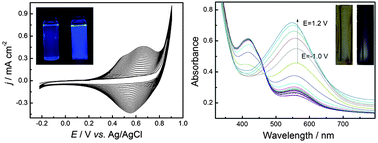Synthesis and electro-optical properties of new conjugated hybrid polymers from EDOT end-capped dibenzothiophene and dibenzofuran†
Abstract
Two novel EDOT end-capped monomers, namely, 2,8-di-2,3-dihydrothieno[3,4-b][1,4]dioxin-5-yl-dibenzothiophene (DBT-EDOT), and 2,8-di-2,3-dihydrothieno[3,4-b][1,4]dioxin-5-yl-dibenzofuran (DBF-EDOT), were synthesised via Stille coupling and electropolymerised to form conjugated polymers P(DBT-EDOT) and P(DBF-EDOT). The monomers exhibited blue-light-emitting characteristics, and DFT calculations revealed band gap values of 4.20 eV for DBT-EDOT and 4.34 eV for DBF-EDOT, while those of the corresponding polymers were brought down to 2.46 eV for P(DBT-EDOT) and 2.58 eV for P(DBF-EDOT), respectively. Moreover, both of the polymers displayed good electrochromic properties with colour switching between yellow in the reduced state and purple in the oxidised state. Structure characterisation and properties of monomers and as-formed polymers using FTIR spectroscopy, UV-vis spectroscopy, surface morphology, fluorescence spectroscopy, electrochemistry, and spectroelectrochemistry, together with structure–property relationships, were systematically investigated and comprehensively discussed.


 Please wait while we load your content...
Please wait while we load your content...